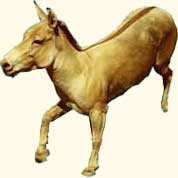














| |
| Wild Ass
Equas hemionus Pallas (Khar Gaddha)—Kutch is well-known for its wild ass. This interesting animal is restricted to the fringes of the Little Rann of Kutch, more so on the southern side in Surendranagar district and around Jinjuvada. According to a rough ocular estimate made by the well-known conservationist Mr. E. P.. Gee in 196the population of wild asses was in the neighbourhood of 870. An aerial census of their population was made in October 1969 by the State Forest Department and their number was provisionally estimated at 362.1 Wild asses have been recently bred in a couple of zoos in the country. This will ensure the species from becoming extinct. The Rann is characterized by flat grassy expanses known as ' bets ' in which coarse grasses spring up vigorously with the monsoon inundations. When the tracts get flooded, herds of wild asses keep to the higher and drier portions on the ' bets ' moving freely from one elevation to another. As summer approaches and the grass in the ' bets ' withers, the wild asses shift to other ' bets ' which have perennial water supply and some green grass throughout the year and congregate in such places in large numbers. They are sturdy and well-built creatures and can gallop at about 50 km. per hour over considerable distances. It is difficult to catch them and more so to keep them in captivity. Young ones can be easily tamed. It is thirteen hands high. has a light brown neck and body, a black stripe down the back, and a white belly. Like the tame ass it has long ears, but its limbs are stronger and better made. Generally moving in herds of ten to fifty, it is sometimes found single or in pairs. According to the local belief, there are, in every herd of wild asses, besides young ones, several grown up animals both male and female. The former Gazetteer records that as each young male comes of age, he fights the head of the herd, and the loser is mutilated and becomes the victor's follower. |

